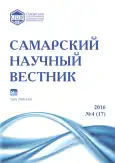Sinergistical aspect of discursive foreign language competence development in future bachelors at non-language institutions in the system of higher education
- Authors: Gorbunov A.G.1
-
Affiliations:
- Udmurt State University
- Issue: Vol 5, No 4 (2016)
- Pages: 169-174
- Section: 13.00.00 – Pedagogical Sciences
- URL: https://journals.rcsi.science/2309-4370/article/view/22190
- DOI: https://doi.org/10.17816/snv20164304
- ID: 22190
Cite item
Full Text
Abstract
The article presents an approach to solve the problem of foreign language competence development in future bachelors in non-language specialties. The author believes that modern educational curricula developers should pursue the idea to make it possible for future bachelors to perceive and produce textuality or dicourses in a foreign language and thus perform well developed discursive foreign language competence. Development of such competence requires that special educational conditions, tuition model and technique should become a part of tutorial methodology aimed at realizing a variety of approaches to form the competence in question in future bachelors in non-language fields. Revelation of such educational conditions and development of tuition model result from synergy of Philology and Pedagogy what allows to develop students’ understanding how the language of communication functions. Their advanced and high level of discursive foreign language competence make it possible for them to efficiently discuss a wide range of topics when their everyday life and professional activities are concerned. The Anglo-Saxon model of communication is being considered as an effective means to make it possible for students to slip from their native language model of communication onto the one in the foreign language. To sum up, understanding of the nature of discourse phenomenon, its systematic features, the algorithm of the Anglo-Saxon model of communication contribute a lot to well-grounded definition of the term ‘discursive foreign language competence’ in pedagogical purposes. Solution to the problem of the discursive foreign language competence development provides future bachelors with a comfortable start in their specialty on the level of international contacts as well as further educational opportunities abroad as they are able to perform advanced and high level of competence when discourse practices of Anglo-Saxon model of communication are concerned. Moreover, future bachelors’ ability to have discursive foreign language practices on their fingertips may retrospectively impact and improve their communication model in the native tongue.
Keywords
Full Text
##article.viewOnOriginalSite##About the authors
Anatoli Gennadyevich Gorbunov
Udmurt State University
Author for correspondence.
Email: votkaizhevsk@gmail.com
associate professor of Chair of Professional Foreign Language for Humanities
Russian Federation, 426034, Izhevsk, Universitetskaya street, 1References
- Горбунов А.Г. Технология формирования дискурсивной компетенции в сфере устного общения студентов нефилологического профиля // Казанский педагогический журнал. 2013. № 4. С. 150–158.
- Алмазова Н.И. Когнитивные аспекты формирования межкультурной компетентности при обучении иностранному языку в неязыковом вузе: автореф. дис. … д-ра пед. наук. СПб., 2003. 47 с.
- Кибрик А.А. Модус, жанры и другие параметры классификации дискурсов // Вопросы языкознания. 2009. № 2. С. 3–21.
- Kaplan R.B. Cultural thought patterns in intercultural education // Language Learning, 1966. № 16. P. 1–20.
- Грайс Г.П. Логика и речевое общение // Новое в зарубежной лингвистике. Вып. XVI. М.: Прогресс, 1985. С. 217–237.
- Chafe W. Integration and involvement in speaking, writing, and oral literature // In spoken and written language: Exploring orality and literacy, ed. D. Tannen–Norwood: Ablex, 1982. P. 35–54.
- Горбунов А.Г. TOEFL-ориентированные технологии формирования иноязычной дискурсивной компетенции у студентов неязыковых направлений обучения: уч.-метод. пособие. Ижевск: Удмурт. ун-т, 2012. Ч. 1. 43 с.
- Карасик В.И. Языковой круг: личность, концепты, дискурс. Волгоград: Перемена, 2004. 390 с.
- Горбунов А.Г. Дискурсивная иноязычная компетенция: онтологический подход // Вестник Томского государственного педагогического университета. 2014. Вып. 6. С. 167–171.
Supplementary files







